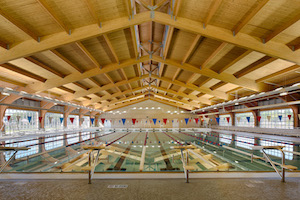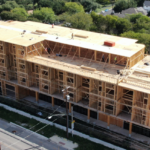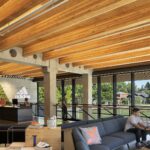Expert Tips
Exposed Wood Structure in Aquatic Centers and Pools
Durability guidance for the use of wood in aquatic environments and other areas of perceived high humidity.

The main durability consideration associated with the use of wood in environments such as pools and aquatic centers is high moisture content in the wood. Buildings such as this may have high relative humidity and, as such, it is important to understand how relative humidity of a condition space affects exposed wood within that space.
In a conditioned building, wood framing will eventually settle into an equilibrium moisture content (EMC) which is a function of the relative humidity and temperature in the space. Table 4-2 of the Forest Products Laboratory’s Wood Handbook provides a matrix table that illustrates this. Mold will not grow on wood when its moisture content (MC) is below 20%.* As illustrated in Table 4-2 of the Wood Handbook, in order to have a MC in excess of 20%, conditions would require a relative humidity in the building of 90% or greater, regardless of the temperature in the space.
This then begs the question—what is the typical range of relative humidity in indoor aquatic centers? This article discusses common temperatures and relative humidity in natatoriums. This information could be used to calculate the EMC of wood framing used in such a space. As the article notes:
ASHRAE recommends maintaining the natatorium air temperature at two to four degrees above the pool water temperature but not above the comfort threshold of 86 degrees F. ASHRAE recommends that the relative humidity in a natatorium be maintained at between 50% to 60% relative humidity.
Using these ASHRAE recommended values for natatoriums—60% RH max and 86 degrees F max—Table 4-2 of the Wood Handbook indicates that the EMC should not exceed 12%, well below the 20% threshold for any concern of decay and mold growth.
The use of exposed wood framing in indoor pools and aquatic centers is nothing new. Below are several examples of exposed timber-framed indoor pool structures:
- Dennis Shippey Aquatic Center
- West Vancouver Aquatic Center
- Grandview Heights Aquatic Center
- Hillcrest Aquatic Centre
- East Hants Aquatic Centre
- Guilford Aquatic Centre
*Mold & Wood Products No. 2: Preventing and Controlling Mold, Western Wood Products Association (requires free account log-in)
Photo Credit:
Dennis Shippey Aquatic Center – Pasadena, TX
cre8 Architects, Matrix Structural Engineers, Gary Zvonnkovic Photography


